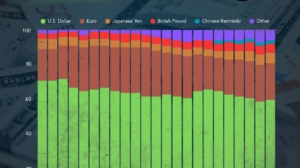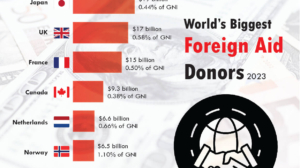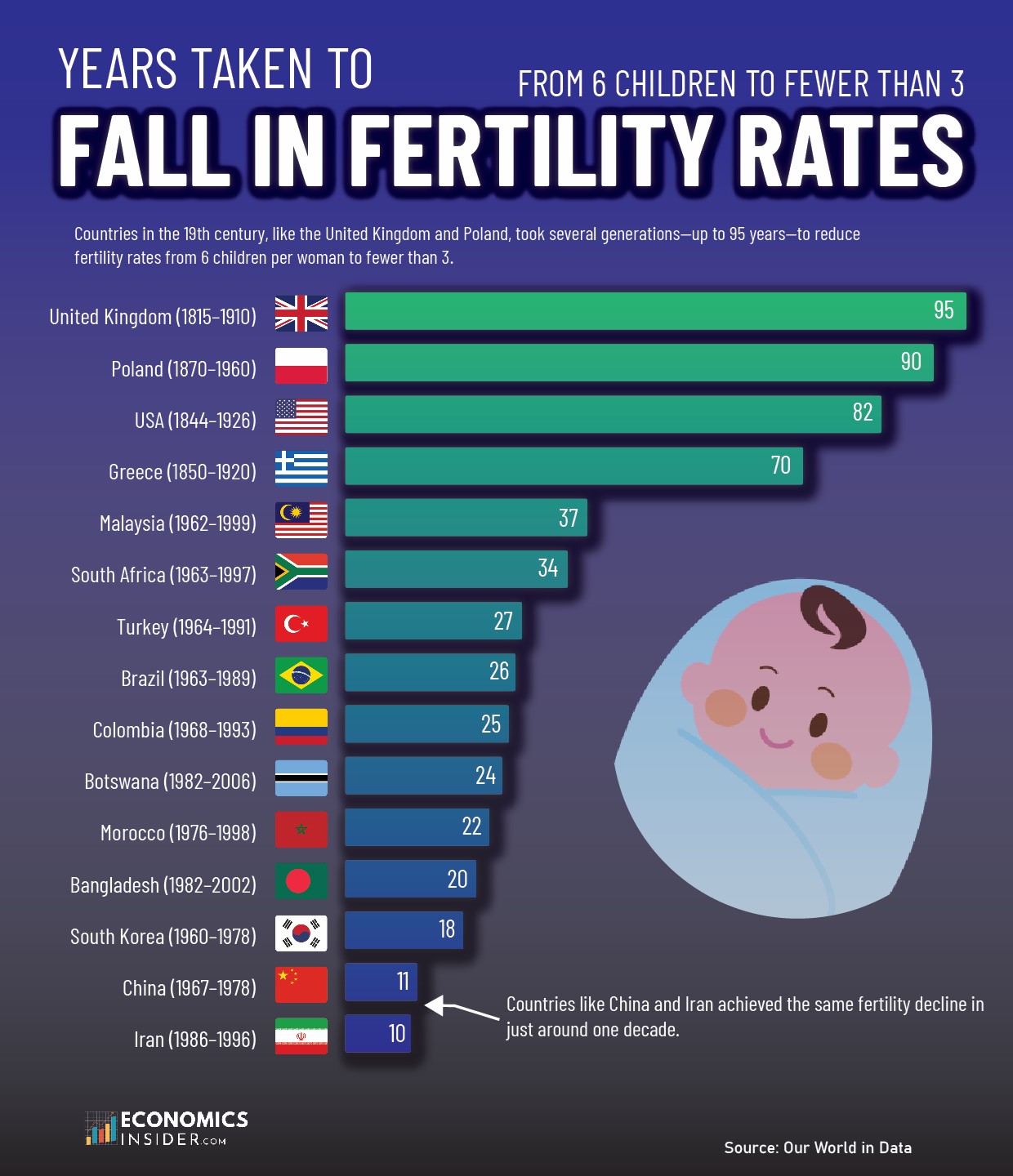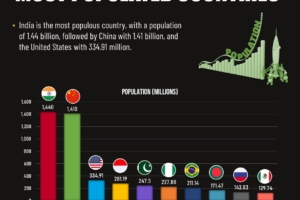Over the past two centuries, countries around the world have seen dramatic changes in birth rates. It took different time periods for countries to reduce their fertility rates from more than 6 children per woman to fewer than 3. The 19th-century nations, like the United Kingdom, took nearly a century to make this shift. However, several countries in the late 20th century did it in just one or two decades. For instance, Iran (1986–1996) reduced its fertility rate from over 6 to below 3 children per woman, followed by China, which took only 11 years to make the same transition.
Key Takeaways
- Countries in the 19th century, like the United Kingdom and Poland, took several generations, up to 95 years, to reduce fertility rates from 6 children per woman to fewer than 3.
- In contrast, many countries in the late 20th century like China and Iran achieved the same fertility decline in just one or two decades.
- This faster transition in recent decades reflects improved access to education, family planning and healthcare services.
How Fast Did Countries Lower Fertility Rates?
The following table shows the number of years it took for countries to reduce their total fertility rate from more than 6 children per woman to fewer than 3.
| Country (Years) | Duration (Years) |
|---|---|
| United Kingdom (1815–1910) | 95 |
| Poland (1870–1960) | 90 |
| USA (1844–1926) | 82 |
| Greece (1850–1920) | 70 |
| Malaysia (1962–1999) | 37 |
| South Africa (1963–1997) | 34 |
| Turkey (1964–1991) | 27 |
| Brazil (1963–1989) | 26 |
| Colombia (1968–1993) | 25 |
| Botswana (1982–2006) | 24 |
| Morocco (1976–1998) | 22 |
| Bangladesh (1982–2002) | 20 |
| South Korea (1960–1978) | 18 |
| China (1967–1978)* | 11 |
| Iran (1986–1996) | 10 |
The data is sourced from Our World in Data.
The data shows how long it took different countries to reduce their fertility rates from six children per woman to below three. In the 19th and early 20th centuries, this change took a very long time, often more than 70 or 80 years. However, by the late 20th century, some countries managed to reduce their fertility rates in just 10 to 20 years.
United Kingdom (1815–1910, 95 years)
The UK was the first country to go through this transition, taking a long 95 years. This was during the Industrial Revolution when modern medicine, urbanization, and the shift away from agriculture began to influence family size. However, the pace was very slow because access to birth control and access to education for women was still very limited.
Poland (1870–1960, 90 years)
Poland’s transition also took almost a century to reduce its fertility rates from six children per woman to below three. The country faced major challenges like wars, political changes, and poverty, which slowed social and economic progress. Additionally, access to education, healthcare, and birth control was very limited at that time. These factors slowed the adoption of family planning and delayed broader societal changes that tend to lower fertility rates.
Population Change of the Top 5 Most Populous Countries By 2050
USA (1844–1926, 82 years)
The United States had a similarly slow but steady decline in fertility rate. The transition period started in the mid-1800s, when life was still rural and large families were common for farm work. At that time, access to birth control was very limited, and ideas about family size changed slowly. Over time, as more people moved to cities, got better education, and had more job opportunities, families started having fewer children.
Iran (1986–1996, 10 years)
One of the most dramatic examples is Iran, where fertility dropped from over 6 to below 3 children per woman in just 10 years. After the Iran-Iraq war, the government actively promoted family planning and made contraceptives widely available. Additionally, public campaigns emphasized smaller families for better economic futures, and it worked remarkably fast.
China (1967–1978, 11 years)
China has the second-largest population globally, following India. It took only 11 years to reduce fertility from over 6 to below 3 children per woman. Although China’s famous one-child policy came later, the fertility rate was already falling rapidly by the late 1960s and 1970s.
South Korea (1960–1978, 18 years)
Unlike Iran and China, South Korea managed this fertility transition quickly. It was due to the rapid industrialization, strong government family planning efforts, and rising education levels among women. The decline in fertility supported the country’s long-term economic growth and social development.
Bangladesh (1982–2002, 20 years)
Bangladesh’s progress is often cited as a success story in public health and family planning. The country managed to reduce fertility with community-based health programs, targeted outreach to women, and international aid.
Brazil and Colombia (1960s–1990s, ~25 years)
Both Brazil and Colombia reduced fertility quickly despite ongoing economic inequality. Urbanization, access to media, and improved health services helped these countries to decline fertility rates, especially in cities.
Malaysia and South Africa (1960s–1990s, ~34–37 years)
These middle-income countries took more than 30 years to reduce their fertility rate. It took a longer period to complete the transition. Yet they still completed it much faster than earlier industrial nations.
Conclusion
Countries in the past took a long time to lower their fertility rates, often needing many decades to make the change. But in more recent years, this shift has happened much faster. With better access to education, healthcare, and family planning, countries have been able to reduce birth rates in just a few decades, or even less.



































Add Comment